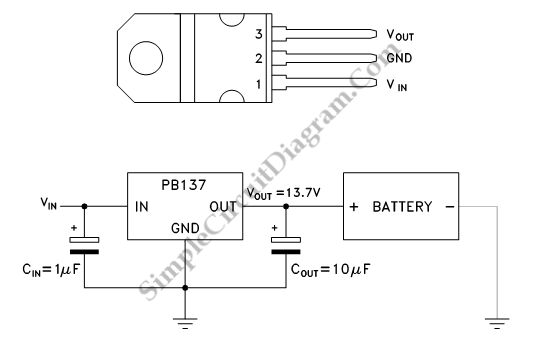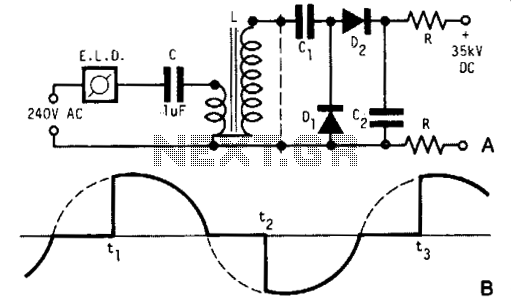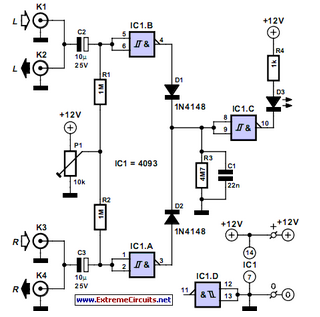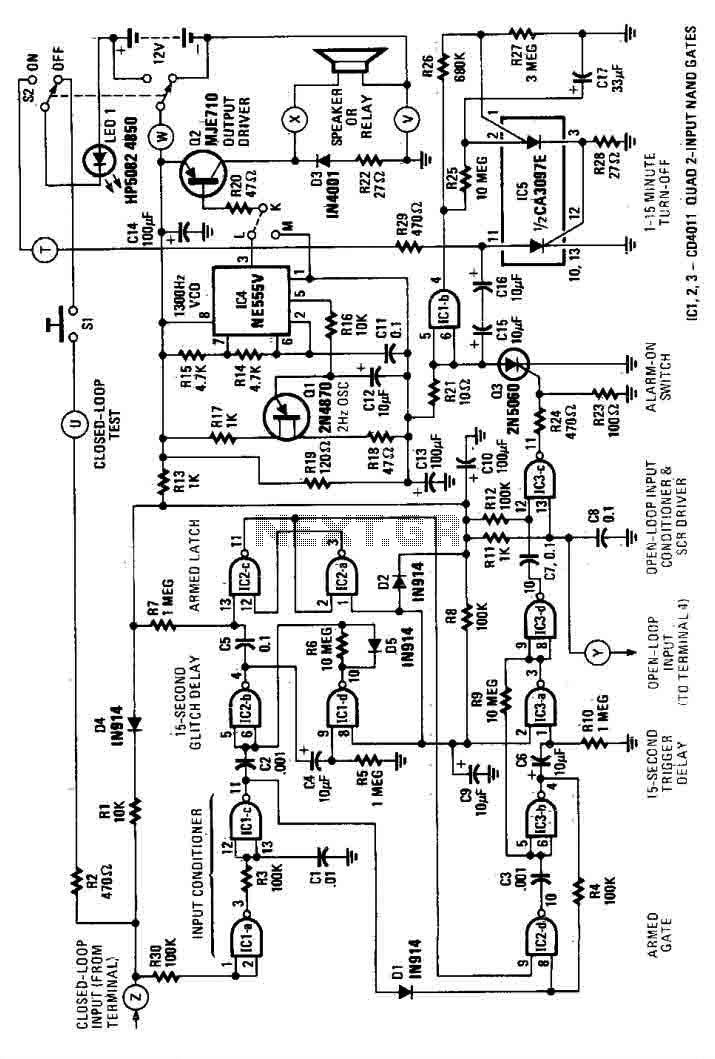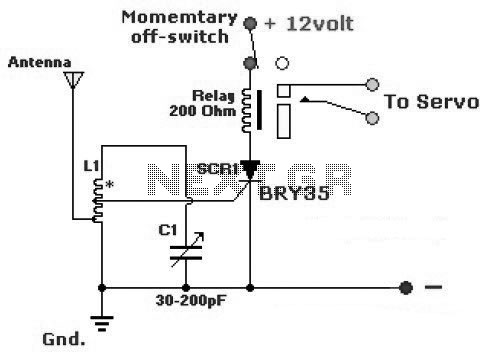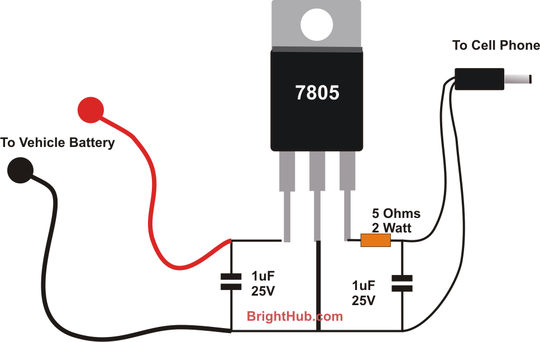
simple FSK/AFSK Modulator

Audio frequency-shift keying (AFSK) is a modulation technique that represents digital data through variations in the frequency (pitch) of an audio tone, resulting in an encoded signal suitable for transmission via radio or telephone. Typically, the transmitted audio alternates between two tones: one, the mark, signifies a binary one; the other, the space, indicates a binary zero. Commercial frequency-shift keying (FSK) modulators tend to be large and require numerous passive components. This circuit utilizes a single NOT gate (inverter), specifically the On Semiconductor NL27WZ14 in a surface mount package, to generate continuous FSK data from TTL-level signals. The frequency range is compatible with the available channels. When the TTL input is low, the circuit continuously outputs an oscillator frequency of approximately 2400 Hz (which can be adjusted using resistor R1). When the input transitions to a high level, the oscillator frequency is halved due to the introduction of a capacitor in the circuit over time, specifically Q1. The converter integrated circuit allows for a surgical frequency of approximately 80 kHz. The operation of the FSK modulator can be easily adjusted to higher frequencies, such as 4800 and 9600 Hz, by reducing the values of the timing capacitors C1 and C2.
The AFSK modulation technique offers a practical solution for transmitting digital data over analog communication channels by leveraging audio tones. The circuit's design, which incorporates a single NOT gate, simplifies the implementation of FSK modulation, making it more accessible for various applications. The On Semiconductor NL27WZ14 inverter functions as the core component that converts TTL-level digital signals into frequency-modulated audio tones.
The oscillator output frequency of 2400 Hz serves as the baseline for the modulation process. The adjustment capability provided by resistor R1 allows for fine-tuning of the output frequency, ensuring compatibility with different transmission standards or requirements. When the TTL input signal is high, the introduction of a capacitor modifies the circuit's time constant, effectively reducing the frequency output. This characteristic allows for the generation of two distinct tones, facilitating the encoding of binary data.
The additional capability to operate at higher frequencies, such as 4800 Hz and 9600 Hz, by adjusting the timing capacitors C1 and C2, provides flexibility in communication applications. This feature is particularly advantageous in environments where bandwidth availability is a critical factor. The design's efficiency and compactness make it an attractive option for integration into various electronic systems that require reliable data transmission through audio signals. Overall, this AFSK modulator circuit exemplifies a streamlined approach to achieving frequency-shift keying suitable for modern communication needs.Audio frequency-shift keying (AFSK) is a modulation technique by which digital data is represented by changes in the frequency (pitch) of an audio tone, yielding an encoded signal suitable for transmission via radio or telephone. Normally, the transmitted audio alternates between two tones: one, the mark , represents a binary one; the other, the
space , represents a binary zero. Commercial FSK (frequency-Shift-keying) modulators are bulky and need many Passive components. the circuit uses a single NOT gate (inverter), On Semiconductor NL27WZ14 into a surface mount Package, to generate continuous FSK data from the TTL level signals. the Spending of this range are compatible with the available channels. If the TTL input is low, the circuit is a continuous execution of the oscillator output about 2400 Hz (adjustable with R1).
If the input assumes a high level of The oscillator frequency reduces by half with the Introduction of a capacitor in the circuit over time Q1. converter IC provides space for surgical Frequency of approximately 80 kHz. You can easily Operation of the FSK modulator at higher frequencies eg, 4800 and 9600 Hz, by reducing the values of the timing capacitors C1 and C2.
🔗 External reference
The AFSK modulation technique offers a practical solution for transmitting digital data over analog communication channels by leveraging audio tones. The circuit's design, which incorporates a single NOT gate, simplifies the implementation of FSK modulation, making it more accessible for various applications. The On Semiconductor NL27WZ14 inverter functions as the core component that converts TTL-level digital signals into frequency-modulated audio tones.
The oscillator output frequency of 2400 Hz serves as the baseline for the modulation process. The adjustment capability provided by resistor R1 allows for fine-tuning of the output frequency, ensuring compatibility with different transmission standards or requirements. When the TTL input signal is high, the introduction of a capacitor modifies the circuit's time constant, effectively reducing the frequency output. This characteristic allows for the generation of two distinct tones, facilitating the encoding of binary data.
The additional capability to operate at higher frequencies, such as 4800 Hz and 9600 Hz, by adjusting the timing capacitors C1 and C2, provides flexibility in communication applications. This feature is particularly advantageous in environments where bandwidth availability is a critical factor. The design's efficiency and compactness make it an attractive option for integration into various electronic systems that require reliable data transmission through audio signals. Overall, this AFSK modulator circuit exemplifies a streamlined approach to achieving frequency-shift keying suitable for modern communication needs.Audio frequency-shift keying (AFSK) is a modulation technique by which digital data is represented by changes in the frequency (pitch) of an audio tone, yielding an encoded signal suitable for transmission via radio or telephone. Normally, the transmitted audio alternates between two tones: one, the mark , represents a binary one; the other, the
space , represents a binary zero. Commercial FSK (frequency-Shift-keying) modulators are bulky and need many Passive components. the circuit uses a single NOT gate (inverter), On Semiconductor NL27WZ14 into a surface mount Package, to generate continuous FSK data from the TTL level signals. the Spending of this range are compatible with the available channels. If the TTL input is low, the circuit is a continuous execution of the oscillator output about 2400 Hz (adjustable with R1).
If the input assumes a high level of The oscillator frequency reduces by half with the Introduction of a capacitor in the circuit over time Q1. converter IC provides space for surgical Frequency of approximately 80 kHz. You can easily Operation of the FSK modulator at higher frequencies eg, 4800 and 9600 Hz, by reducing the values of the timing capacitors C1 and C2.
🔗 External reference
